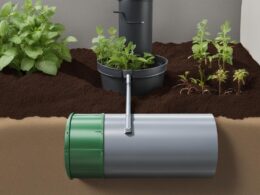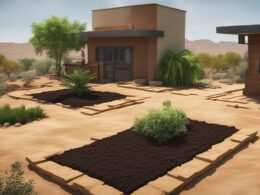Are you looking to create a stunning garden that not only adds beauty to your landscape but also conserves water? Consider designing a xeriscape garden. Xeriscaping is a landscaping technique that focuses on water efficiency and uses drought-resistant plants. By embracing xeriscape design principles, you can create a sustainable and visually appealing garden while minimizing water consumption.
Key Takeaways:
- Xeriscape gardens are designed to be water-efficient and utilize drought-resistant plants.
- By planning your xeriscape garden carefully, you can make the most of your landscape and minimize water usage.
- Selecting the right plants based on their water needs is crucial for a successful xeriscape garden.
- Implementing water-wise techniques such as mulching and rainwater harvesting can further enhance the sustainability of your xeriscape garden.
- Xeriscape gardens can be visually stunning with the use of colorful drought-resistant plants and container gardening.
Understanding Xeriscape Landscaping
Xeriscape landscaping is a term used to describe a landscape that requires minimal water. It involves using plants that are naturally adapted to dry climates and drought-resistant species. Xeriscape gardens can be designed by combining plants from North America and other dry climate regions around the world. This style of landscaping is especially popular in the western states where water concerns are high. By adopting xeriscape techniques, homeowners can create beautiful landscapes without the need for a traditional lawn.
Dry landscaping strategies play a key role in xeriscape design. These strategies focus on minimizing water consumption while still achieving an aesthetically pleasing garden. Some common techniques include using gravel or mulch as ground cover instead of grass, incorporating hardscapes such as rocks or pavers, and creating focal points with sculptures or architectural elements. By reducing the amount of water-intensive features in your landscape, you can effectively conserve water while maintaining the visual appeal of your outdoor space.
Water conservation is a fundamental principle of xeriscape landscaping. By selecting plants that are native to your region or have low water requirements, you can significantly reduce your water usage. Grouping plants together based on their water needs ensures efficient watering, as plants with similar water requirements can be irrigated together. Additionally, implementing efficient irrigation systems such as drip irrigation or soaker hoses delivers water directly to the root zones, minimizing water loss through evaporation or runoff. These strategies not only conserve water but also promote healthier and more resilient plant growth.
Benefits of Xeriscape Landscaping
“Xeriscape landscaping is not only environmentally friendly but also offers numerous benefits for homeowners. By reducing water usage, xeriscaping can help lower water bills and conserve resources. The use of drought-resistant plants requires less maintenance, saving both time and money. Additionally, xeriscape gardens can enhance the curb appeal of your property and increase its value.”
In summary, xeriscape landscaping is a sustainable approach to creating beautiful and water-efficient gardens. By understanding the principles of xeriscape design, incorporating dry landscaping strategies, and focusing on water conservation, homeowners can achieve a visually stunning landscape while minimizing their environmental impact. Implementing xeriscape techniques not only saves water and reduces maintenance efforts but also contributes to a more sustainable future.
Planning Your Xeriscape Garden
When designing a xeriscape garden, careful planning is essential to ensure its success. By addressing problem areas in your landscape and managing the size of your lawn, you can create an efficient and visually appealing xeriscape garden that conserves water.
Start by identifying problem areas in your landscape that are challenging to water and maintain. These areas may include steep slopes, narrow strips of lawn, rocky terrain, or spots prone to drought. By recognizing these problem areas, you can strategize ways to minimize water usage and maximize the efficiency of your garden.
Another crucial aspect of planning your xeriscape garden is managing the size of your lawn. Consider designating areas of high-traffic turf grass and converting other portions of your lawn to drought-tolerant plants, shrub borders, or flower gardens. This not only reduces the amount of water required but also adds visual interest and diversity to your landscape.
By carefully planning the layout of your xeriscape garden, taking into account problem areas and lawn size management, you can create a sustainable and water-efficient landscape that thrives with minimal water resources.
Selecting the Right Plants for Your Xeriscape Garden
Choosing the right plants is a crucial step in designing a xeriscape garden. Opt for plants that are native to your region and well-suited to your specific climate. Drought-tolerant plants that can thrive with minimal water are ideal for a xeriscape garden.
Grouping plants together based on their water needs is another important consideration. By grouping plants with similar water requirements, you can ensure efficient watering practices and minimize water usage. This not only helps conserve water but also creates a harmonious and visually pleasing garden design.
Incorporating drip irrigation or a soaker hose system is an effective way to deliver water directly to the roots of the plants, reducing water loss through evaporation and promoting deep root growth. This targeted watering approach is in line with the principles of xeriscape gardening, emphasizing water conservation and efficiency.
Selecting the Right Plants for Your Xeriscape Garden
One of the key aspects of designing a xeriscape garden is selecting the right plants. It’s important to choose both native and drought-tolerant plants that are suited to your specific climate and can thrive with minimal water. Here are some tips to help you make the right plant choices for your xeriscape garden:
- Research native plants: Native plants are naturally adapted to the local climate and soil conditions, making them well-suited for xeriscape gardens. Look for plants that are native to your area and have low water requirements.
- Consider drought-tolerant plants: In addition to native plants, you can also incorporate drought-tolerant plants from other regions that have similar climates. These plants have the ability to survive with limited water and require less maintenance.
- Group plants by water needs: To ensure efficient watering, group plants together based on their water requirements. This allows you to target water to specific areas and avoid overwatering or underwatering. For example, group plants that have high water needs together and separate them from plants that require less water.
By carefully selecting plants that are well-suited to your climate and grouping them based on their water needs, you can create a thriving and water-efficient xeriscape garden that is both beautiful and environmentally friendly.
Quote:
“Choosing the right plants is essential in xeriscape gardening. It’s all about finding species that can handle the climate and soil conditions in your area. Look for plants that are adapted to dry climates and have low water requirements. These plants are more likely to thrive in your xeriscape garden and require less maintenance.”
Grouping plants by water needs
Grouping plants together based on their water needs is a key strategy in xeriscape gardening. This allows you to efficiently water your garden and avoid wasting water. Here are some guidelines for grouping plants:
- High water needs: Plants that require frequent watering should be grouped together. This ensures that they receive adequate moisture without overwatering other plants.
- Moderate water needs: Plants that have moderate water needs can be grouped together. These plants typically require watering less frequently, but still need regular moisture.
- Low water needs: Drought-tolerant plants that have low water requirements can be grouped together. These plants can survive with minimal water and should be separated from plants that need more moisture.
By grouping plants based on their water needs, you can create a more efficient watering system and conserve water in your xeriscape garden.
Water-wise Techniques in Xeriscape Design
Xeriscape gardening not only creates a water-efficient landscape but also promotes sustainability. To enhance the effectiveness of your xeriscape garden, it’s important to implement water-wise techniques. Here are some key practices to consider:
Soil Improvement
Improving the quality of your soil is essential for a successful xeriscape garden. Adding organic matter, such as compost or well-rotted manure, can help increase soil moisture retention and improve water absorption. This allows your plants to access water more effectively, reducing the need for frequent watering.
Mulching
Mulching is an effective way to conserve moisture and reduce evaporation, making it a valuable technique in xeriscape design. Apply a layer of organic mulch, such as wood chips or straw, around your plants to help retain soil moisture and regulate soil temperature. Mulch also helps suppress weed growth, reducing competition for water.
Capturing Runoff
Preventing water runoff is crucial in water-wise gardening. By creating dry streambeds or rain gardens, you can capture and redirect rainfall into the soil. This helps replenish groundwater and prevents wastage. Additionally, these features can add aesthetic appeal to your xeriscape garden, creating visually interesting elements.
Rainwater Harvesting
Rainwater harvesting is an excellent way to supplement your water supply and reduce reliance on municipal water sources. Install rain barrels or other water storage systems to collect rainwater from your roof. This collected water can be used for irrigation, minimizing your impact on local water resources.
Drip Irrigation
Drip irrigation systems deliver water directly to the roots of your plants, reducing water loss due to evaporation and runoff. This method is highly efficient and ensures that water is used where it’s needed the most. Installing a drip irrigation system can help maximize the water efficiency of your xeriscape garden.
Implementing these water-wise techniques in your xeriscape design will not only conserve water but also result in a healthier and more sustainable garden. By improving soil moisture retention, mulching, capturing runoff, using rainwater, and utilizing drip irrigation, you can create an environmentally friendly and visually appealing xeriscape garden.
Enhancing the Aesthetics of Your Xeriscape Garden
Designing a xeriscape garden doesn’t mean sacrificing aesthetics. In fact, there are various styles and techniques that can enhance the visual appeal of your water-efficient landscape. Whether you prefer a Mediterranean-inspired oasis or a vibrant display of colorful flowers, there are options to suit your personal taste and the unique characteristics of your garden.
Exploring Xeriscape Garden Styles
When it comes to xeriscape garden styles, the possibilities are endless. You can create a Mediterranean-inspired retreat with drought-resistant plants like lavender, rosemary, and agave, complemented by pathways made of gravel or decorative stones. Alternatively, you can embrace a Southwest garden style, characterized by the use of cacti, succulents, and desert shrubs, along with vibrant pottery and vibrant mosaics.
“A well-designed xeriscape garden can be a beautiful tapestry of colors, textures, and shapes, showcasing the resilience and diversity of drought-resistant plants.”
Adding Colorful Drought-Resistant Plants
Gone are the days when drought-tolerant meant dull and monotonous landscapes. Today, you can include a wide range of colorful flowering plants in your xeriscape garden. Opt for vibrant perennials like coneflowers, black-eyed Susans, and salvia, which will bring pops of color throughout the year. Don’t forget to incorporate ornamental grasses and evergreen succulents to add texture and visual interest to your garden.
Embracing Container Gardening
Container gardening offers a versatile and space-efficient way to showcase drought-resistant plants in your xeriscape garden. Choose decorative pots in various shapes and sizes and fill them with a mix of colorful annuals and perennial flowers. This allows you to experiment with different plant combinations and easily rearrange your garden whenever you feel like refreshing the look. Container gardening is also a great option if you have limited space or want to create a focal point on your patio or balcony.
By embracing xeriscape garden styles, incorporating colorful drought-resistant plants, and exploring container gardening, you can create a visually stunning landscape that conserves water and thrives all year round. With careful planning and attention to detail, your xeriscape garden will become an oasis of beauty, sustainability, and environmental consciousness.
How Can I Incorporate Pollinator-Friendly Features in My Xeriscape Garden Design?
When planning your xeriscape garden design, consider incorporating pollinator-friendly features to attract xeriscape garden design pollinators like bees, butterflies, and hummingbirds. Plant native flowers, use mulch, and provide water sources to create a welcoming environment for these important pollinators while maintaining a water-efficient landscape.
Conclusion
Xeriscape gardening is a sustainable and water-efficient landscaping technique that allows you to create a beautiful and environmentally-friendly garden while conserving water. By understanding the principles of xeriscape design, planning your garden layout, selecting the right plants, and implementing water-wise techniques, you can achieve a successful xeriscape garden.
Whether you live in a dry climate or simply want to contribute to water conservation efforts, designing a xeriscape garden is a rewarding and fulfilling endeavor. With the right strategies in place, you can enjoy a flourishing garden that requires minimal water and maintenance.
Start designing your xeriscape garden today and enjoy the benefits of a sustainable and water-efficient landscape. Not only will you be reducing your water consumption, but you’ll also be creating a beautiful outdoor space that complements your surroundings and positively impacts the environment. Embrace the beauty of xeriscape gardening and make a difference in water conservation.














